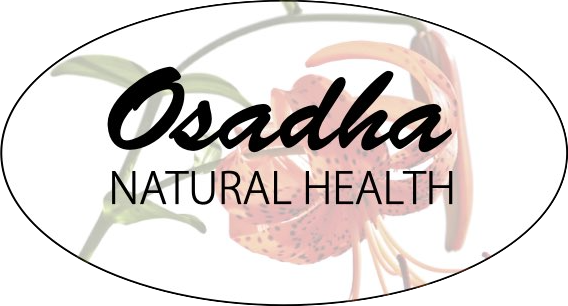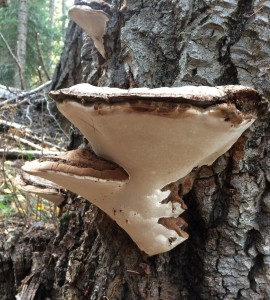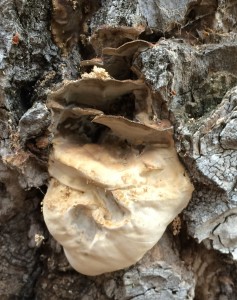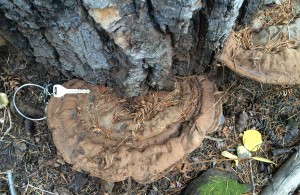This is an excerpt from an article I published in Plant Healer Magazine and will presenting on at this June’s Good Medicine Confluence in Durango….
Artist’s Conk (Ganoderma applanatum)
This mushroom gets around, living in all 50 states and in temperate climes around the globe. Also known as “Red Mother Fungus” or “Ancient Ling Zhi (Spirit Mushroom)”, Artist’s Conk is not as well known in the US as it’s cousin Reishi (Ganoderma lucidum), medicinally speaking. Indeed, Reishi has been much more heavily studied than it’s various Ganoderma cousins. I don’t think this is necessarily due to it being “better” medicine than the others. In fact, mushrooms of various Ganoderma ilk have been used for thousands of years in China and other parts of Asia. Plus getting to know the local species doesn’t seem like a bad idea.
Conks are hard shelf-like mushrooms found on trees, stumps and logs. What are typically called “mushrooms” are really just the sex parts, or to be more scientific, the “fruiting body” that releases spores for reproduction. The organism itself lives inside the host, which in the case of Artist’s Conk, is a wide variety of dead or dying trees, particularly Aspen here in Colorado.
The top of Artist’s Conk is brown and furrowed, while the bottom surface from which spores are released is bright white, standing out along a shady stream side. A key identifier is that marks made on the white surface immediately turn brown. You can draw on it, hence the name! The top is often coated with a layer of cocoa-colored spores on top that get there from below via static attraction. Despite the name Ganoderma (“shiny skin”), the surface of Artist’s Conk is not shiny, though the conk does live up to the applanatum (“flattened”) part of the name (1).
Artist’s Conk is perennial, with new growth each year leading to new furrows on the surface. Large ones may be many years old. Folks on the Elbert Creek walk this June will meet a group of conks I visit every year that have been there since long before I moved to the area in 2010. I don’t collect large ones out of respect for the number of years that went into making them, though some foragers will collect the outer inch or two from around the edge of bigger conks.
I’ll mention just a few medicinal properties of Artist’s Conk here and save the rest for the Good Medicine Confluence.
Like it’s cousin, Reishi, Artist’s Conk is an immune system tonic and a good way to be ready for cold and flu season. Immune tonics, as opposed to immune stimulants, are not traditionally used during a cold or flu virus infection, but are instead used ahead of time for prevention. Though I recently had telltale signs of a budding respiratory infection: Slight fever, itchy throat and the beginnings of a cough. Artist’s Conk was all I had with me, and I know that if I don’t get on it immediately, I’m screwed. So I tried multiple doses over an hour or two and the symptoms subsided. Was it because the infection was still pretty early on? Would it have worsened the infection if I tried it later? Don’t know. Though Artist’s Conk is noted for use in respiratory infections by Christopher Hobbs, who, by the by, played a significant role in introducing the concept of medicinal mushrooms to the US through his aptly named book “Medicinal Mushrooms”.
Artist’s Conk can be used interchangeably with Reishi for allergies. Though best as a daily tonic to prepare for allergy season, it also works acutely for allergy symptoms. A squirt or two of double extract (tincture combined with decoction) is enough to quash my morning stuffiness as fall allergy season kicks in. It won’t work for everyone, but if it’s “your” remedy, it will be effective quickly. Reishi reduces allergy symptoms in part by preventing release of pro-inflammatory chemicals from mast cells (2) that are responsible for wheeziness, runny nose, itchy eyes and such. Given the similarity in chemistry between the two mushrooms, it wouldn’t be surprising if Artist’s Conk is doing something similar. But, then, who cares…as long as it works.
Reishi is used to improve oxygen exchange in the lungs and is used by climbing guides in the Himalayas to help them reach the highest points in the world. Something I’d like to find out about Artist’s Conk for use here in Durango (not quite as high as the Himilayas, but…).
~~~
Content © Dr. Anna Marija Helt, Osadha Natural Health, LLC. Permission to republish any of the articles or videos in full or in part online or in print must be granted by the author in writing.
The articles and videos on this website for educational purposes only & have not been evaluated by the Food and Drug Administration. This information is not intended to diagnose, treat, cure, or prevent any disease or to substitute for advice from a licensed healthcare provider.



